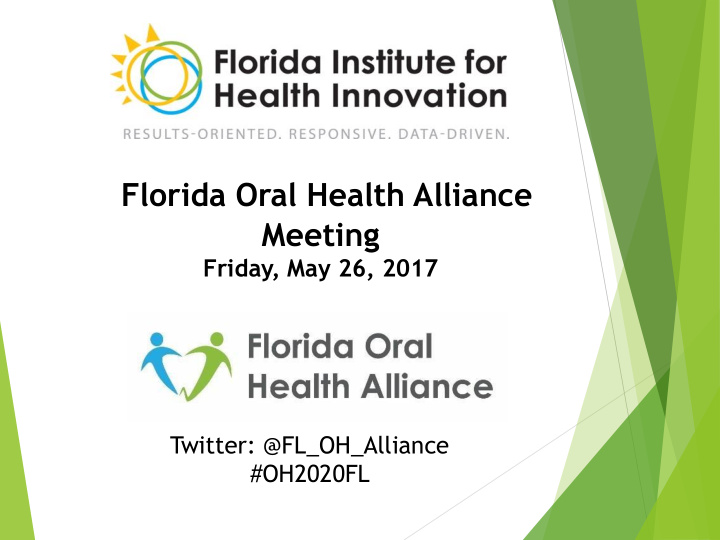



Florida Oral Health Alliance Meeting Friday, May 26, 2017 Twitter: @FL_OH_Alliance #OH2020FL
Result: All Florida children, youth and families have good oral health and well-being, especially those that are vulnerable. 7/14/201 2 7
Headline Indicator #1: Percentage of Medicaid-eligible Children Ages 0 - 20 Receiving any Dental Services 50% 47% 47% 45% 46% 46% 45% 40% 35% 35% 30% 29% 29% 25% 27% 23% 20% 15% 10% 5% 0% 2011 2012 2013 2014 2015 Florida Source: Florida Form CMS-416 line 12a data retrieved in August 2016 from the Florida Institute for Health Innovation.
Headline Indicator #2: Percentage of Medicaid-eligible Children Ages 1 - 20 Receiving Preventive Dental Services 50% 45% 45% 44% 43% 42% 41.50% 40% 35% 33% 30% 27% 25% 25% 20% 19% 15% 14% 10% 5% 0% 2011 2012 2013 2014 2015 Florida National average Source: Florida Form CMS-416 line 12b minus <1 data retrieved in August 2016 from the Florida Institute for Health Innovation .
Meeting Results By the end of the meeting participants will have: Received an update on the Oral Health 2020 Florida State Alignment Meeting Reviewed feedback from the Oral Health Consumer Advisory Council Discussed goals and objectives for the next phase of the Florida Oral Health Alliance Decisions regarding how to align Alliance strategies with existing community-level initiatives Identified Alliance leads for specific oral health focus areas (school-based sealant programs, oral health policy, improved data collection, etc.) Agreed upon next steps for the Alliance
Update on Oral Health 2020 Florida State Alignment Meeting National Policy Landscape Impacts to oral health and public health funding in Florida Strategies for framing work within the priorities of current administration Overview of Florida Voices for Health Federal and state policy updates Developing a shared oral health policy and advocacy agenda
Consumer Advisory Council Recommendations Increase awareness and utilization of special-needs 1. dentistry programs (among parents) and training resources (among providers). Develop/update comprehensive oral health resource 2. guides that allow consumers to search for specific services based on zip code, health plan and area of need. Educate direct service providers (including physicians) 3. working with oral health consumers about the dental care system and strengthen referral networks. Increase reimbursement rates and incentives for 4. Medicaid providers and those treating vulnerable populations.
IMPACT & DIFFICULTY MATRIX (Numbered in order of preference and probability of results) High Impact 4. Medicaid reimbursement rates 1. Special-needs dentistry 2. Resource guide programs 3. Educate direct service providers Low Difficulty High Difficulty 8 Low Impact
Next Steps for the Florida Oral Health Alliance Shift from a discussion group to facilitators of local oral health implementation and alignment efforts Identify and prioritize Alliance strategies best positioned for alignment with current county and community-level oral health initiatives Identify members of the Alliance that can serve as primary contacts/leads for oral health focus areas
Strategy Ideas 1. **Create and consistently implement oral health education and messaging in the community for parents and guardians regarding the importance of oral health prevention and how it relates to educational attainment. (Focus area – Oral Health Education) 2. **Encourage and incentivize the provision of inter-professional education and training for medical and allied health professionals regarding oral health to include oral health screenings and risk assessment and placement of fluoride varnishes. (Focus area – Oral Health Education) 3. Develop Emergency Department diversion programs . (Focus area – Barriers to Oral Health Care) 4. Increase outreach efforts by managed care plans to improve access to dental care by aligning with community stakeholders to maximize local resources. Stakeholders include hospitals, school districts, academic and medical and allied health training institutions, health providers, state and county agencies, and various community groups such as charities, foundations and other non-for profits. 10 (Focus area – Barriers to Oral Health Care)
Strategy Ideas 5. Utilize primary care/pediatric providers so that children can receive medical and dental treatment on the same day. (Focus Area - Barriers to Oral Health Care) 6. Advocate for required oral health exams for school entry (Focus Area-Barriers to Oral Health Care) 7. Expand school-based oral health programs through sharing best practices already in place. (Focus Area - Barriers to Oral Health Care) 8. Promote management of caries by using new prevention models in the dental delivery system. (Focus Area – Need for Increased Funding) 9. Establish real time data collection systems to include sharing between plans, medical care, dental care and schools in order to assess needs and address barriers. (Focus Area – Data Collection) 11
Strategy Prioritization 1. Feasibility (or reach) Is the proposed strategy or action plan feasible? Can it be done in the current “environment”? 2. Leverage How strongly will the proposed strategy or action impact progress as measured by the baselines? How many people in our target population will it impact? 3. Values alignment Is the strategy consistent with the values of the oral health community and overall health care delivery?
Strategy Prioritization Example Survey Question: Strategy #1: Create and consistently implement oral health education and messaging in the community for parents and guardians regarding the importance of oral health prevention and how it relates to educational attainment. Rate this strategy based on its level of feasibility, leverage and values alignment: 1. Feasibility: High Medium Low 2. Leverage: High Medium Low 3. Values Alignment: High Medium Low
Next Steps for the Florida Oral Health Alliance What type of support would this require? What type of meeting format and schedule would be useful? What additional stakeholders or groups need to be engaged? What resources or materials would be needed?
Recommend
More recommend